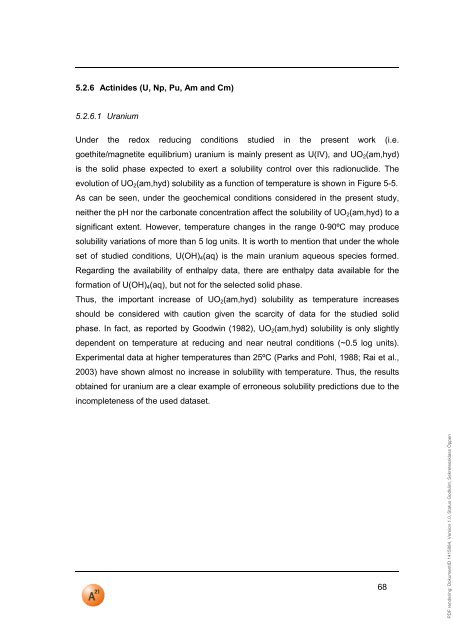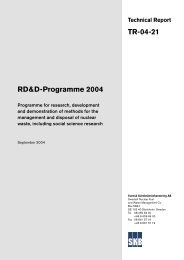pH = 11 - SKB
pH = 11 - SKB
pH = 11 - SKB
You also want an ePaper? Increase the reach of your titles
YUMPU automatically turns print PDFs into web optimized ePapers that Google loves.
PDF rendering: DokumentID 1415884, Version 1.0, Status Godkänt, Sekretessklass Öppen5.2.6 Actinides (U, Np, Pu, Am and Cm)5.2.6.1 UraniumUnder the redox reducing conditions studied in the present work (i.e.goethite/magnetite equilibrium) uranium is mainly present as U(IV), and UO 2 (am,hyd)is the solid phase expected to exert a solubility control over this radionuclide. Theevolution of UO 2 (am,hyd) solubility as a function of temperature is shown in Figure 5-5.As can be seen, under the geochemical conditions considered in the present study,neither the <strong>pH</strong> nor the carbonate concentration affect the solubility of UO 2 (am,hyd) to asignificant extent. However, temperature changes in the range 0-90ºC may producesolubility variations of more than 5 log units. It is worth to mention that under the wholeset of studied conditions, U(OH) 4 (aq) is the main uranium aqueous species formed.Regarding the availability of enthalpy data, there are enthalpy data available for theformation of U(OH) 4 (aq), but not for the selected solid phase.Thus, the important increase of UO 2 (am,hyd) solubility as temperature increasesshould be considered with caution given the scarcity of data for the studied solidphase. In fact, as reported by Goodwin (1982), UO 2 (am,hyd) solubility is only slightlydependent on temperature at reducing and near neutral conditions (~0.5 log units).Experimental data at higher temperatures than 25ºC (Parks and Pohl, 1988; Rai et al.,2003) have shown almost no increase in solubility with temperature. Thus, the resultsobtained for uranium are a clear example of erroneous solubility predictions due to theincompleteness of the used dataset.68
















